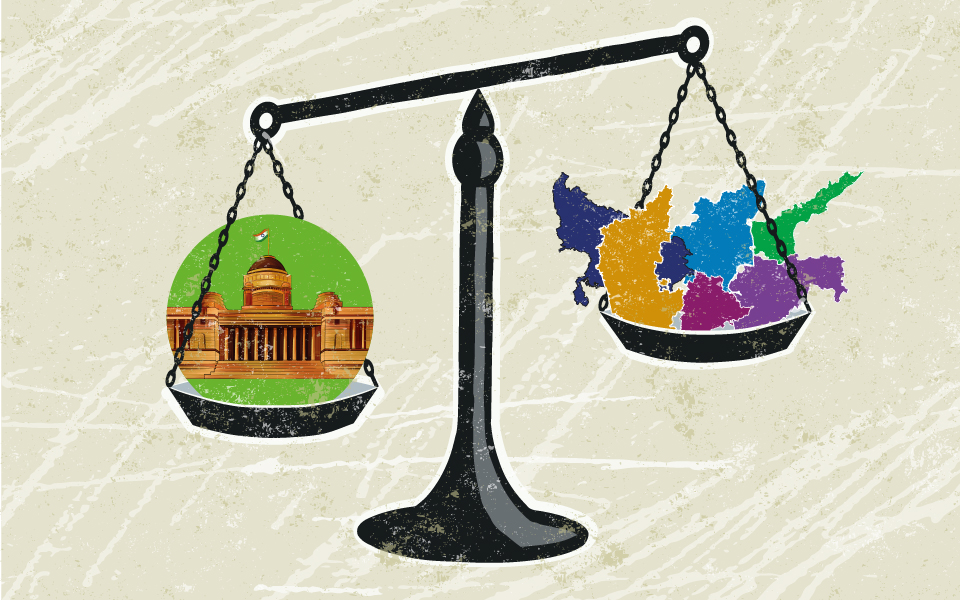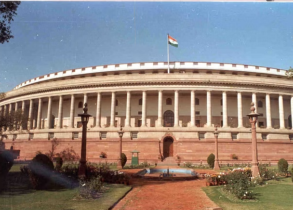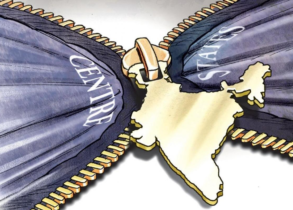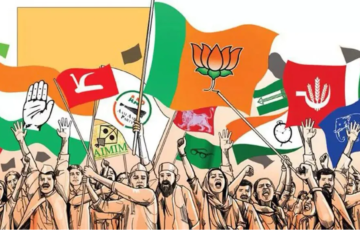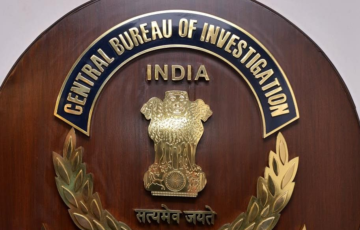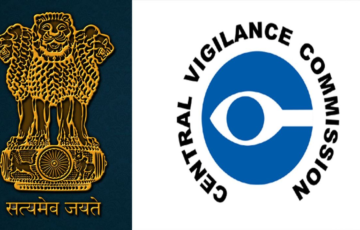FEDERAL SYSTEM
Introduction
- Political scientists classify governments into unitary and federal models based on the relationship between the national government and regional governments. Unitary governments have all powers vested in the national government, while federal governments divide powers between the national government and regional governments by the Constitution. Countries like Britain, France, Japan, China, Italy, Belgium, Norway, Sweden, Spain, and others have a unitary model, while the US, Switzerland, Australia, Canada, Russia, Brazil, and Argentina have a federal model. A federation is a new state formed through a treaty or agreement between various units, known by various names like states, cantons, provinces, or republics.
Evolution of Federations: Integration, Disintegration, and India’s Federalism”
- Formation of Federations Integration Model: Federations can be established in two primary ways, with the first approach being the integration model. In this scenario, a group of militarily weak or economically disadvantaged independent states unite to create a larger and more robust union. A classic example of this model is the United States, where initially weak or economically challenged states came together to form a strong and cohesive union.
- Disintegration Model In the second approach, a significant unitary state transforms into a federation by granting greater autonomy to its provinces. This transformation is designed to promote regional interests, and Canada is a notable example of the disintegration model.
- Historical Examples: United States The United States, formed in 1787 following the American Revolution (1775–83), is widely recognized as the world’s first and oldest federation. It comprises 50 states, originally 13 states, and serves as a model of a federation formed through the integration model.
- Canada The Canadian Federation, initially composed of four provinces and established in 1867, is another historical example. This federation exemplifies the disintegration model, where a substantial unitary state granted greater autonomy to its provinces to promote regional interests.
- Indian Constitution and Federalism: Motivation for Federalism India’s Constitution establishes a federal system of governance for the nation. This decision was primarily motivated by two crucial factors: the vast size of the country and its remarkable socio-cultural diversity. The framers of the Constitution recognized that federalism not only allows for efficient governance but also harmonizes the ideals of national unity and regional autonomy.
- The Terminology: ‘Union of States’ It is worth noting that the term ‘federation’ is conspicuously absent in the Indian Constitution. Instead, Article 1 of the Constitution characterizes India as a ‘Union of States.’ Dr. B.R. Ambedkar, one of the framers, explained that the phrase ‘Union of States’ was chosen over ‘Federation of States’ to convey two fundamental concepts. First, it signifies that the Indian federation is not a result of a state-level agreement, as seen in the American federation. Second, it underscores that the states do not possess the right to secede from the federation, indicating the indestructibility of this ‘Union.’
- The Indian Federal System: Rooted in the ‘Canadian Model’ The Indian federal system is fundamentally based on the ‘Canadian model’ rather than the ‘American model.’ The ‘Canadian model’ significantly differs from the ‘American model,’ particularly in its approach to centralization.
- Key Characteristics of the ‘Canadian Model’ The Indian federation shares several key characteristics with the ‘Canadian model’:
- Formation Through Disintegration: Both federations were established through the disintegration model, where a unitary state grants greater autonomy to its provinces.
- Preference for the Term ‘Union’: Both India and Canada use the term ‘Union’ to describe their federations, highlighting a common feature.
- Centralization Tendency: In both federations, there is a tendency to centralize power, with the central government holding more authority in comparison to the states.
Federal Features of the Constitution
- Dual Polity: The Indian Constitution establishes a dual polity, a distinctive federal characteristic. This dual polity comprises the Union government at the Center and individual state governments at the periphery. Each entity possesses sovereign powers that are exercised within their respective domains as defined by the Constitution. The Union government deals with issues of national significance such as defense, foreign affairs, currency, and communication, while state governments focus on regional and local matters like public order, agriculture, health, and local governance.
- Written Constitution: The Indian Constitution is not just a written document but also stands as one of the world’s lengthiest constitutions. Originally, it encompassed a Preamble, 395 Articles divided into 22 Parts, and 8 Schedules. As of 2019, it consists of a Preamble, approximately 470 Articles divided into 25 Parts, and 12 Schedules. This comprehensive written document meticulously delineates the structure, organization, powers, and functions of both the Central and state governments. It also sets clear boundaries within which they must operate. This written nature of the Constitution helps prevent misunderstandings and conflicts between the Union and states.
- Division of Powers: The Constitution distinctly divides powers between the Central government and the state governments, underscoring federalism. This division is delineated in the Seventh Schedule, where subjects are categorized into the Union List, State List, and Concurrent List. The Union List contains 98 subjects (originally 97), the State List comprises 59 subjects (originally 66), and the Concurrent List encompasses 52 subjects (originally 47). Both the Central government and state governments can enact laws concerning subjects on the Concurrent List. However, in the event of a conflict, the Central law takes precedence. Additionally, subjects not mentioned in any of these lists, known as residuary subjects, are assigned to the Center.
- Supremacy of the Constitution: The Indian Constitution is the supreme law of the land. All laws enacted by both the Central and state governments must adhere to its provisions. Any laws or actions that deviate from the constitutional framework can be declared invalid by the Supreme Court or high courts through their power of judicial review. This supremacy of the Constitution sets the boundaries within which all government organs – legislative, executive, and judicial – at both levels, must operate.
- Rigid Constitution: The maintenance of the division of powers and the supremacy of the Constitution necessitates a rigid amending process. Specifically, provisions related to the federal structure, which involves Centre-state relations and judicial organization, can only be amended through a joint effort of the Central and state governments. Amending such provisions requires a special majority in Parliament and the approval of half of the state legislatures, ensuring that amendments do not undermine the federal framework.
- Independent Judiciary: The Constitution establishes an independent judiciary headed by the Supreme Court, serving two critical purposes. First, it safeguards the supremacy of the Constitution by exercising the power of judicial review, ensuring that government actions adhere to constitutional norms. Second, it serves as the arbiter in disputes between the Central government and states or among states. The Constitution includes provisions to guarantee judicial independence, such as security of tenure for judges and fixed service conditions, preventing the judiciary from being subject to undue influence by the government.
- Bicameralism: The Indian Constitution outlines a bicameral legislature comprising an Upper House (Rajya Sabha) and a Lower House (Lok Sabha). While the Lok Sabha represents the entirety of India’s population, the Rajya Sabha specifically represents the states within the Indian Federation. Although the Rajya Sabha has relatively lesser legislative powers, its primary role is to maintain the federal balance by safeguarding state interests against excessive interference by the Central government. This feature reinforces the federal structure of Indian governance.
Unitary Features of the Indian Constitution
- Single Citizenship: Unlike federal systems where there are dual citizenships (one for the nation and one for the state), the Indian Constitution provides for single citizenship. All Indian citizens are governed by a uniform set of citizenship laws and enjoy the same rights and privileges across the country.
- Integrated Judiciary: While the judiciary plays a vital role in interpreting and upholding the Constitution, there is a unified judiciary in India. The Supreme Court, as the apex judicial body, has jurisdiction over cases related to both Central and state laws. There isn’t a separate system of state and federal courts as seen in some federal systems.
- Appointment of Governors: In a federal structure, governors of states are often elected or appointed through a state-specific process. In India, governors are appointed by the President of India, who represents the Union government. This centralized appointment process contributes to the unitary nature of the office.
- Single Constitution: In federal systems, there are often separate constitutions for the Central government and individual states. In India, there is a single Constitution that applies uniformly to the entire country. While there are provisions for amendments and special provisions for certain states, the fundamental legal framework remains consistent.
- Power to Redraw State Boundaries: The Indian Constitution provides for the reorganization of states and the alteration of state boundaries. This central authority to alter state borders is a unitary feature that allows for the creation or merging of states without needing unanimous consent from the states involved.
- Emergency Provisions: During times of emergency, the Indian Constitution grants the Central government significantly expanded powers. The ability to declare a state of emergency, whether due to external aggression, armed rebellion, or constitutional breakdown, can lead to the temporary centralization of authority and suspension of certain federal principles.
- Residuary Powers: While the division of powers is specified between the Union and states, any powers not explicitly mentioned in any of the lists (Union List, State List, or Concurrent List) are vested in the Union. These residuary powers grant the Central government additional authority in areas not explicitly allocated to either level of government.
- Appointment of Services: The Indian Administrative Service (IAS) and the Indian Police Service (IPS), among other central services, are administered and controlled by the Central government. These services are responsible for key administrative and law enforcement functions in the states, demonstrating a degree of central authority in personnel administration.
- Union Territories: Union Territories (UTs) in India are areas directly administered by the Central government. While some UTs have their legislatures and administrations, others are governed entirely by the Union government. This arrangement reinforces the unitary nature of governance in specific regions.
- Single Unified Judiciary: While India has a federal structure, it maintains a single, unified judicial system. There is no separate court system for state laws and Central laws. The Supreme Court has the authority to adjudicate on matters of constitutional interpretation and disputes arising from both state and Central legislation.
- These unitary features within the Indian Constitution demonstrate the country’s unique blend of federal and unitary characteristics. While federal principles are an essential aspect of the Indian system, the unitary features ensure that the Union government can act decisively when necessary and maintain the unity and integrity of the nation.
Critical Evaluation of the Federal System
Strengths of the Indian Federal System:
- Decentralization of Power: The Indian federal system, with its division of powers between the central government and states, promotes local governance. Dr. B.R. Ambedkar, a key architect of the Indian Constitution, recognized the significance of a dual polity to prevent excessive centralization.
- Cultural and Regional Diversity: India’s federalism is well-suited to manage its cultural and regional diversity. Mahatma Gandhi, the father of the nation, emphasized the importance of preserving and promoting India’s rich cultural and linguistic diversity within a united nation.
- Checks and Balances: The Indian federal structure incorporates checks and balances between the central and state governments, in line with the views of political philosophers like Montesquieu. This separation of powers helps protect individual rights. The Supreme Court of India has affirmed federalism as a fundamental feature in cases like the Bommai case.
- Innovation and Policy Experimentation: The Indian federal system allows states to serve as “laboratories of democracy,” where they can experiment with policies to address local needs. This reflects the ideals of leaders like Sardar Patel, who emphasized the importance of preserving the autonomy of states.
- Conflict Resolution: India’s federal system effectively manages and resolves conflicts between different regions, languages, and ethnic groups. Leaders like Jawaharlal Nehru and scholars like K.C. Wheare have recognized the importance of federalism in maintaining peace and managing internal diversity.
Weaknesses of the Indian Federal System:
- Coordination Challenges: Coordinating policies and actions across multiple levels of government can be complex and inefficient, often leading to overcentralization. This challenge was emphasized by leaders like K. Santhanam.
- Inequality: Economic disparities between states can be exacerbated in India’s federal system, leading to inequalities in resource distribution. Scholars and leaders have raised concerns about regional imbalances and disparities in development.
- Fragmentation and Conflict: India’s highly autonomous states can sometimes lead to fragmentation and conflicting interests. This has led to regionalism and conflicts, which need to be carefully managed.
- Political Gridlock: The presence of multiple governments can lead to political gridlock, where disagreements between the central and state governments hinder decision-making. Critics have argued that India’s federal system can sometimes slow down policy implementation.
- National Unity Challenges: India’s federal system faces challenges in maintaining national unity. Leaders such as Sardar Patel played a crucial role in integrating princely states into the Indian Union. However, separatist movements and ethnic conflicts continue to pose challenges.
- Administrative Costs: Running multiple levels of government can be expensive, with administrative and bureaucratic costs increasing. Scholars and experts have emphasized the need for efficient governance to manage the costs.
| Aspect | Federal Government | Unitary Government |
| Structure | Dual Government (national and regional) | Single Government (national) |
| Constitution | Typically a written constitution | May be written (e.g., France) or unwritten (e.g., UK) |
| Division of Powers | Clear division of powers between national and regional governments | No division of powers; all authority vested in the national government |
| Supremacy of the Constitution | Constitution is usually supreme, serving as the highest law | Constitution may be supreme (e.g., Japan) or not supreme (e.g., UK) |
| Constitution Flexibility | Often rigid, requiring special procedures for amendments | Constitution may be rigid (e.g., France) or flexible (e.g., UK) |
| Independence of Judiciary | Typically includes an independent judiciary | The independence of the judiciary varies; may be more or less independent |
| Legislature Structure | Commonly bicameral at the national level (e.g., the United States) | Can be bicameral (e.g., France) or unicameral (e.g., China) |
| Control Over Subdivisions | Regional governments have significant control over various policy areas (e.g., taxation, education) | Regional entities, if they exist, derive their powers from the national government |
| Resource Distribution | Regional governments may have control over revenue sources and distribution (e.g., in India) | National government typically has control over revenue and resource distribution |
| Amendment of Constitution | Typically requires a special and often complex procedure, safeguarding federal principles | Amendment procedures may vary; may be easier or more flexible |
| Fiscal Independence | Regional governments often have fiscal independence, allowing them to raise and allocate funds | Fiscal powers are usually vested in the national government, which may distribute funds to local entities |
| Local Autonomy | Subnational entities enjoy substantial autonomy in areas such as education, healthcare, and law enforcement | Local governments, if they exist, have limited autonomy and derive authority from the central government |
| Examples | United States, India, Germany | United Kingdom, Japan, China |
UPSC PREVIOUS YEAR QUESTIONS
1. Which one of the following in Indian polity is an essential feature that indicates that it is federal in character? (2021)
1. The independence of the judiciary is safeguarded.
2. The Union Legislature has elected representatives from constituent units.
3. The Union Cabinet can have elected representatives from regional parties.
4. The Fundamental Rights are enforceable by Courts of Law.

